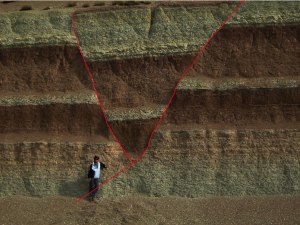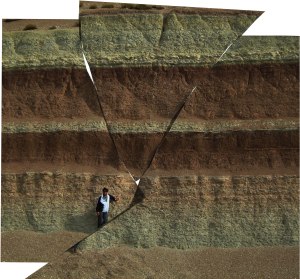This beautiful picture of a graben near Zanjan, Iran was taken by Mehdi Jahangiri and Reza Alipour. These are pretty clean faults, but if you look closely you will see that they are not perfectly planar.
Changes in dip occur across layer boundaries, and particularly as the left-dipping fault enters the lower bleached layer.
This post has at least two purposes; 1) to show a nice picture of normal faults, and 2) to show that simple restoration may be both fun and useful.
A quick interpretation shows that the left-dipping fault is the main fault, and that the left-dipping one is the antithetic fault. Note that the antithetic fault does not appear to crosscut the main fault.
Once the interpretation is done, the section begs to be restored. Now this is a picture, with all the distortion that comes with whatever lens was used, but a quick and dirty digital (Photoshop) restoration can still give important information about the deformation. I am talking about rigid block restoration where blocks can be translated and rotated.
The restored section looks pretty good. The main problem is where the main fault changes dip in the lower part of the section. The overlap is shown as a dark shade. Although I have not been to the outcrop, this is where we would expect to find the most small-scale deformation (damage), and detailed investigation of the picture indicates that this is indeed the case. Also elsewhere there are some minor overlaps and gaps along the restored faults, which in part is taken up by vein fill that can be seen in the unrestored picture. You could also change the interpretation (if the geology allows you to do so) and try again.
Thanks to Mehdi Jahangiri for sharing this nice picture!




Thanks for your interesting and very good analysis from this photo
Excellent !
Looking at that fascinating picture was fantastic. Thanks to photographer, Mehdi Jahangiri, and sincerely thanks to Prof. Haakon Fossen for his accurate interpretation.
This graben is so beautiful! It’s just like made for a textbook.
Nice faults! I’m just trying to get a Geology/Outdoors blog started. Any suggestions?
Alex
13164539
That is an eye catching picture, I must say.
If its a normal fault why didn’t the left part went down instead of right?
A graben is composed of two normal faults dipping toward each other. Going from one side to the other it means stepping down across the first fault, then stepping back up across the second.
Hi Haakon,
When we search for real graben example to explain it by animation we fond your great topic about graben, So we doing animation on it. you can find it here: http://gph.to/1Uom1GO
Very cool!
Haakon
>
Hi there – thanks for the very interesting and informative post! May I ask a question: when you refer to the ‘right-dipping fault’ as the main fault, is this the fault dipping towards the right of the image, or the fault which in the majority of the image is closer to the right. I ask because I read it to mean the fault dipping towards the right of the image – but from your interpretation and the red fault ‘lines’ you drew on the image it looks more as though the fault dipping towards the left of the image was the main fault, because the fault dipping towards the right ends where it meets the one dipping towards left (while the one dipping left continues further)? Apologies if I have just missed something or misinterpreted what you said – I haven’t studied antithetic and synthetic faults yet (just finished first year of geology at university) so it might be that I don’t fully understand the terminology. Thanks if you are able to answer!
Hey Max, this one definitely is my fault :). Sorry about that. Thanks a lot for pointing out the error. Text corrected.
Thank you! – so the left dipping fault is the main fault and the right dipping one is the antithetic fault. Thanks again for posting the image and reconstruction which are very interesting, and for the clarification. (Also, I like the pun 🙂 )